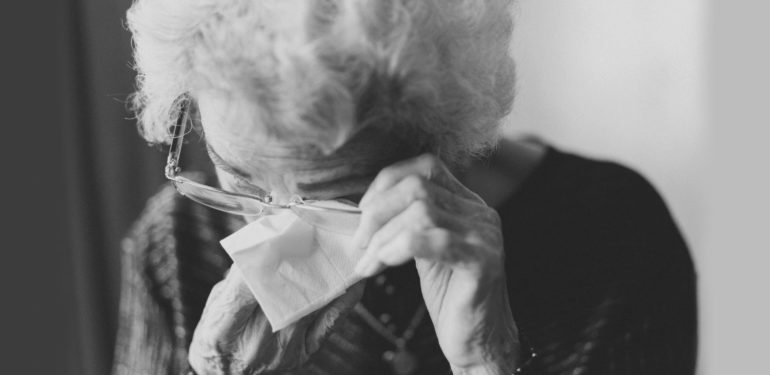Heartbreak. That’s the only word to describe the scene outside of Canada’s long-term care homes. Teary-eyed relatives mouth “I love you” through windows to their elderly parents or grandparents on the other side. Ambulance visits are a regular occurrence, as the COVID-19 virus ravages these residences, preying on its vulnerable inhabitants.
Our elders are dying by the dozens.
Let’s be honest– in a culture focused on the newest, fastest, and hottest – the oldest (and arguably wisest) members of our society are often an afterthought. This sad reality is especially stark here in North America when compared to other parts of the world. As the sorry state of long-term care homes and the vulnerability of our senior citizens to COVID-19 continue to dominate headlines, however, the pandemic has opened our eyes to the realities of being elderly – realities that extend well beyond the typical physical and cognitive challenges often associated with aging.
It took a global pandemic, but all eyes are on the 65-plus demographic like never before.
For nearly two months now, COVID-19 has essentially forced most of us to forego the freedoms and pleasures of our pre-pandemic lives, as we’ve adapted (some more successfully than others) to social isolation measures. Young people – especially those who live alone – can now relate to the feelings of isolation and loneliness, the restlessness of restriction, and the longing for times past that typically characterizes those in their older years. We’ve gotten a taste of life as an isolated senior citizen; we’re confined in solitude, planning our days around our next meals, and anticipating something as simple as a phone call with a friend with excitement. In short, we’re experiencing perpetual monotony on a whole new level.
Since the term ‘social isolation’ became a staple in our collective vocabulary, I appreciate the importance of both of my late grandmothers’ conscious and unwavering efforts to lead active social lives well into their 70s and early 80s – whether this meant square dancing sessions, games of bridge, books club meetings, or coffee dates. I now understand the tears of joy in their eyes when I arrived to visit (even when they could no longer recall exactly who I was), and those of pain when it was time to leave, like I never did before. I realize why repeating and reliving those stories of their glory days meant so much. Hell, I even find myself basking in the nostalgia of my own carefree glory days (cue the 90s hip-hop and R&B), and of the pre-COVID world in general.
I know I’m not alone.
Feelings of loneliness and isolation can and do have serious health consequences for senior citizens, even when a global pandemic is absent from the equation. Countless studies have shown correlations of both factors with issues like obesity, high blood pressure, cognitive decline, depression, anxiety, and more. Judging from the emerging mental health struggles of some of my prime-aged peers during this time of social isolation, none of this is too surprising. Companionship is a powerful force, and its absence can be crushing.
Of course, the psychological toll of isolation on senior citizens – in COVID-19 times or not – is just one part of the issue. The state of countless long-term care and nursing homes throughout the crisis has been brutally horrific. Most have been beyond starved for resources. To claim COVID-19 testing has been lacking across the board is an understatement. In many of these homes, society’s most vulnerable have been left unattended and ignored for hours on end thanks to staffing shortages. In a couple of them, scared and fed up employees have actually even walked off the job.
If we don’t know someone living in a long-term care facility, most of us have certainly imagined what it would be like to have a parent or grandparent in one at this time.
It’s not a pleasant thought.
The sad reality is that problems in long-term care homes persisted long before COVID-19 hit Canada; the novel coronavirus just savagely exposed them. The bottom line is that these long-term care homes simply weren’t prepared for a pandemic. They haven’t adapted from the learning experience of the SARS crisis like hospitals and other healthcare facilities have. Often, this is no fault of their own; it’s no secret that the government hasn’t historically prioritized long-term care facilities. Many have battled shortages in both the staffing and funding fronts for years before COVID-19 came along.
Although provinces like Ontario and British Columbia have recently banned the (grossly underpaid) long-term care employees from working in multiple homes – something that enables the virus to easily spread between these facilities – doing so was actually identified as problematic years ago, in the wake of SARS. Yet, the practice persisted, one deadly flu season after another.
Systemic issues existed long before the pandemic
In Ontario, systematic shortcomings in long-term care homes were also highlighted in a 2019 inquiry in response to the case of former nurse/serial killer Elizabeth Wettlaufer, who murdered eight elderly patients. While the Ontario government had been responding to outlined recommendations pre-pandemic, a CBC report also revealed that the government virtually stopped conducting unannounced annual inspections of the province’s long-term care homes. The same report highlighted inexcusable issues of hygiene, neglect, and abuse inside some homes.
Ontario’s Premier Doug Ford has said he believes the province must open an inquiry into long-term care once the pandemic has passed. Furthermore, on May 5, SEIU Healthcare, a union representing thousands of Ontario health-care workers, called on the province of Ontario and police forces to launch a public inquiry and criminal investigations into COVID-19-related deaths at long-term care homes. There’s now even talk of making long-term care a universal, publically funded system under the Canada Health Act. Change is most definitely on the horizon.
On a positive note, the focus is finally on our impossible-to-ignore elders as we fight to save their lives and plan ahead to ensure Canada’s long-term care homes and the people who staff them are exactly where they need to be moving forward. Our elderly and those who care for them will, hopefully, now be prioritized in the wake of this crisis. Interestingly (and perhaps another silver lining), this awakening comes at a time when the parents of millennials are starting to qualify for senior citizen status. Our generation is realizing that our mothers and fathers aren’t invincible. It’s going to be our parents in these homes in the not-too-distant future. And new waves of COVID-19 are very possible. Let that sink in.
We can’t accept this current reality, and I suspect that few of us will.
As our parents approach old age, we’ll share a silent understanding of their plight, thanks to lessons learned through these trying times.
If there’s anything this pandemic is going to inspire, it’s a reminder not to take one minute of time spent with loved ones – particularly in person – for granted. At the very least, once this is all over, going to visit our aging parents and grandparents will be time that we treasure, and not something we reluctantly squeeze into our schedules.
In the meantime, there is no shortage of ways you can help a senior citizen during COVID-19, in everything from adopting a senior in need virtually (for real) to assisting in shopping for essentials. In Toronto, Sinai Health’s Circle of Care program – a not-for-profit home care provider – is seeking donations of things like hand sanitizer, masks, gloves, and gowns, as well as grocery and drugstore gift cards.
Header photo by Jeremy Wong from Unsplash


